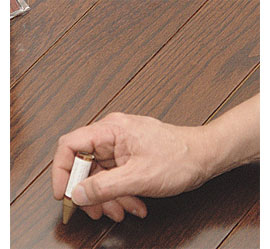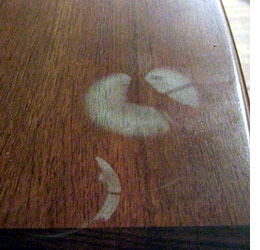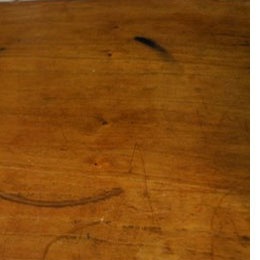Hide scratches on furniture
No matter how carefully you look after your furniture, there will come a time when you need to fix up scratches, stains, burns or wear. Here’s what you can do about it:
Use your nut - You can hide a fine scratch on furniture by rubbing it with the meat of a pecan or other oily nut, or with a little peanut butter. But if this sounds a bit too nutty or smelly, there are alternatives. It's actually the oil in the nut that's doing the job, and olive or vegetable oil will work even better - without the danger of further damaging the finish by rubbing too hard. Rub the oil in well with your thumb, and polish the surface using a clean soft cloth.
Instant solution - For a brew that will obscure scratches on a dark furniture finish, mix 1 teaspoon of instant coffee in 1 tablespoon of water or vegetable oil. Don't use this on shellac or a valuable antique.
More home scratch eliminators -
Several other common household items can hide small scratches on finished wood. Here are some to try, but test them in an inconspicuous spot first and make sure that when you do apply them, you keep your coverage to the smallest possible area:
- Iodine works on mahogany and other reddish finishes.
- Liquid and wax shoe polish come in shades that match wood finishes.
- Felt-tip markers let you match a range of wood tones.
- Crayons in similar colours also work if warmed slightly first to soften them.
Basic scratch removal - Simply applying wax polish and buffing will often eliminate fine scratches. For more pronounced marks, sand with the grain using superfine wet-or-dry sand-paper lubricated with mineral oil (or baby oil). To get an even shine and a satin finish, rub the area with superfine steel wool lubricated with oil soap. For a higher shine, wax and buff. But don't wet-sand older veneer pieces; they often have tiny high spots where the finish will wear off.
Marker magic - A worn finish on a chair arm or table edge can be fixed with special touch-up pens - available from wood-finishing suppliers - that seal and refinish worn spots and scratches. Wipe the area with mineral spirits and scuff it with superfine sandpaper. Then draw over it with a pen of the appropriate colour. Feather out the repair by rubbing it gently with your finger. Repeat several times to build up the new finish.
White rings - A white ring left by a sweaty beverage container will often disappear if you just wipe up the moisture and wait a couple of hours.
If the ring persists, try passing a hair dryer - set on low heat - back and forth over it, but keep the nozzle at least 150 mm away and allow the wood to get warm but not hot. If a trace still remains, rub it vigorously with boiled linseed oil (or olive or vegetable oil); then buff with your palm to create friction. Wipe clean.
Spilled nail polish - Don't wipe it up! The solvents in nail polish soften most finishes, and wiping may take off the finish. Instead, let the polish dry completely; then gently scrape it off with a credit card. Wax the surface, using superfine steel wool.
Pearly and plaque-free - To brighten a dulled lacquer or varnish finish, mix a little regular non-gel toothpaste with water and rub it on with a cloth. If necessary, blend in a pinch of baking soda to make it more abrasive.
Scorched surface - To remove a surface burn, rub it with a paste made of fine fireplace ash and lemon juice. Then wipe the area clean, and touch it up with the same kind of finish that is already on the surface.
Burn marks - To treat burns that go into the wood, mask closely around the area with tape, and scrape out the charred wood using a craft knife with a rounded blade.
If necessary, stain the bare wood to match the finish.
Mix equal parts of clear nail polish and acetone-base nail polish remover, and apply one thin coat at a time until you fill the hole, letting each coat dry before applying the next. Sand the surface with extra-fine paper, and then remove the tape. If a burn goes through a veneer, patch the veneer.
popular mechanic



